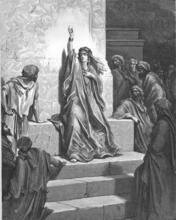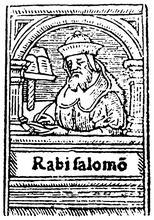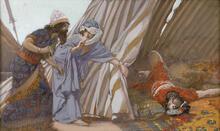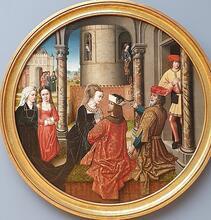Yael Wife of Heber The Kenite: Midrash and Aggadah
The midrash praises Yael and includes her among the devout women converts. The Rabbis expressed their positive attitude toward Yael, regardless of whether they believed that there was no sexual act between her and Sisera or that they understood that he had, in fact, lain with her. Her actions were guided by a clear goal, and even if they entailed a sin, she acted for the sake of Heaven and thereby saved Israel from annihilation. Yael’s actions helped God to realize God’s plan by punishing Sisera measure for measure for his wicked deeds, and by affording Israel a military victory over its enemies.
The A type of non-halakhic literary activitiy of the Rabbis for interpreting non-legal material according to special principles of interpretation (hermeneutical rules).midrash praises Yael, wife of Heber the Kenite, and includes her among the devout women converts, together with Hagar, Asenath, Zipporah, Shiphrah, Puah, the daughter of Pharaoh, Rahab, and Ruth (Yalkut Shimoni on Joshua, para. 9, from Midrash Tadshe). Yael was apparently beautiful, because merely hearing her voice would cause men to recall her and would arouse their lust (BT Lit. "scroll." Designation of the five scrolls of the Bible (Ruth, Song of Songs, Lamentations, Ecclesiastes, Esther). The Scroll of Esther is read on Purim from a parchment scroll.Megillah 15a).
Yael and Sisera in the Tent
The Biblical narrative is somewhat vague as to precisely what happened between Yael and Sisera in the tent before he fell asleep. Jud. 4:18 relates: “So he entered her tent”; is this Scripture’s euphemistic description of his having intercourse with her, or is the text simply to be understood literally?
There are two approaches to this question in Rabbinic literature. According to one, Sisera did not touch Yael. He fled to her and begged her: “Please give me some water,” and she opened the skin of milk and gave him some to drink. His evil urge was aroused, and he demanded that she sin with him. What did she do? She took the tent peg and drove it through his temple (Midrash ha-Gadol, Vayeshev 29:8 [ed. Margaliot], p. 663). Another midrash adds that by merit of Yael’s flight from sin, God included His name with hers, and publicized her innocence. The Rabbis deduce this from the words (Jud. 4:18): “and she covered him with a semikhah.” They note that semikhah is a hapax legomenon (a word that appears only once in the Bible), and seek to interpret it. Some Palestinian Rabbis explain that Yael covered Sisera with a garment, while Babylonian Rabbis argue that she covered him with a large washing bowl, under which he would be concealed. A third view maintains that this unique word is meant to publicize Yael’s innocence, and is to be read with the letter shin, and as two words: shemi kan (My name is here)—God’s name attests that the wicked one did not touch Yael (Lev. Rabbah 23:10). This exegetical account clears Yael of any blame, and emphatically declares that nothing happened between her and Sisera when she brought him into her tent.
Another account, however, has Sisera lying with Yael, which is learnt from Jud. 5:27 (1917 JPS translation): “At her feet he sunk, he fell, he lay; at her feet he sunk, he fell; where he sunk, there he fell down dead.” The words “sunk,” “fell” and “lay” recur a total of seven times in this verse, from which these Rabbis derive that Sisera engaged in intercourse with Yael seven times during their encounter. This approach also clears Yael of any guilt, and establishes that “sin for Heaven's sake is greater than fulfilling a commandment that is not done for Heaven's sake.” This sinful intercourse in which Yael engaged with Sisera was for Heaven’s sake, in order to exhaust him so that she could then kill him. Accordingly, Yael’s action is greater than the performance of a commandment performed not for Heaven's sake. This is learned from the Song of Deborah (Jud. 5:24): “Most blessed of women be Yael, wife of Heber the Kenite, most blessed of women in tents.” The midrashic exposition understands the “women in tents” to be Sarah, Rebekah, Rachel and Leah, each of whom is mentioned in reference to a tent; Yael’s deed is more blessed than those of the four Matriarchs (BT Nazirite; person who vows to abstain for a specific period (or for life) from grape and grape products, cutting his hair, and touching a corpse.Nazir 23b). One possible explanation of this midrash, that places Yael on a higher level than the Matriarchs of the Jewish nation, is that the latter engaged in sexual relations for pleasure and to produce offspring, while Yael acted with the sole aim of killing Sisera. Another explanation of the Talmudic dictum, by Rashi, is that the Matriarchs told their husbands to come to their handmaidens, intending this not for a sacred purpose, but because they were jealous of one another, and consequently Yael’s deed was greater than theirs.
Yael the Savior
Another exegesis understands “most blessed of women in tents” as a reference either to the four Matriarchs or to the women of the wilderness generation who dwelled in tents, for without Yael’s deed, their descendants would have been lost (Gen. Rabbah 48:15). According to this interpretation, the death of Sisera, Jabin’s military commander, proved decisive in the war and resulted in Israel’s victory over the Canaanites. Thus Yael’s deed ensured the continued existence of the people of Israel. Yet another exposition comments that Yael did her husband’s bidding when she seduced Sisera, thereby meriting to be the agent of the great deliverance (Seder Eliyahu Rabbah 12).
An additional midrashic teaching that demonstrates the Rabbis’ favorable attitude to Yael’s deed declares that “whoever undertakes to perform a commandment, that commandment shall not cease from his house.” Jethro took into his home Moses, the redeemer of Israel, who had fled from the hated Pharaoh who sought to kill him, and he therefore merited that his offspring would include Yael, who would receive in her home Sisera, the foe of Israel, who had fled from Barak son of Ahinoam, the military commander and redeemer of the Israelites, and would kill this Canaanite (Ex. Rabbah 4:4). This midrash links Yael with Jethro, who is also called a Kenite (and is mentioned in Jud. 4:11). Since hospitality was especially important among nomadic tribes, it might be argued that Yael sinned by harming a guest who came to take shelter with her: instead of granting him protection, she murdered him. The midrash, however, praises her actions, regards them as equally important as Jethro’s hospitality, and presents them as a A biblical or rabbinic commandment; also, a good deed.mitzvah, a religiously commendable act.
The Rabbis categorized Sisera’s unique death as an instance of a measure-for-measure punishment. He had strongly oppressed the Israelites, and severely blasphemed and reviled [gadaf] them, and therefore died a gedufah [cursed or despicable] death, when the Lord gave him over to a woman, who (Jud. 5:26) “crushed his head, smashed and pierced his temple” (Num. Rabbah 10:2). Another midrash applies the verse from the Eshet Hayil (“Woman of Valor”) passage (Prov. 31:19): “She sets her hand to the distaff” to Yael, who did not kill Sisera with a conventional weapon, but with a tent peg, with the strength of her hands (Midrash Eshet Hayil 31:19, Batei Midrashot, vol. 2.).
All the above midrashim, taken as a whole, teach that the Rabbis expressed their positive attitude to Yael, regardless of whether they explained that there was no sexual act between her and Sisera or whether they understood that he had, in fact, lain with her. Her actions were guided by a clear goal, and even if this entailed a sin, she acted for the sake of Heaven, and thereby saved Israel from annihilation. Yael’s actions helped God to realize His plan by punishing Sisera measure for measure for his wicked deeds, and by affording Israel a military victory over their enemies.










